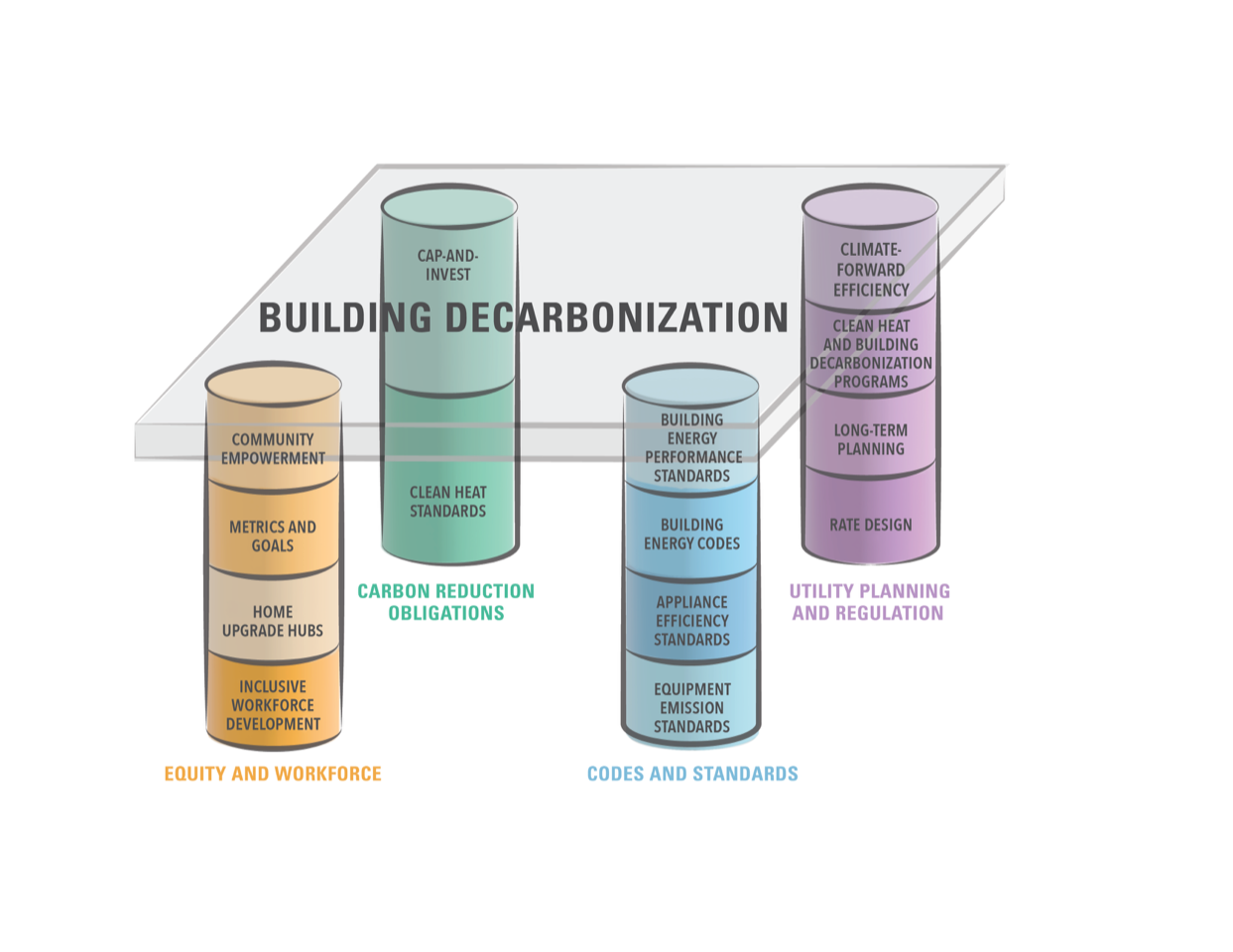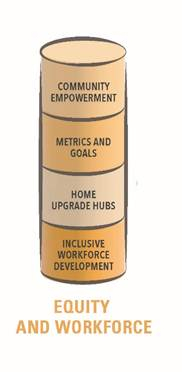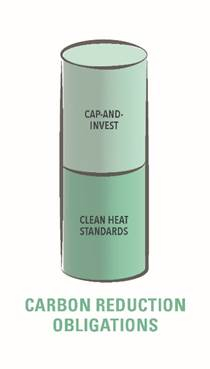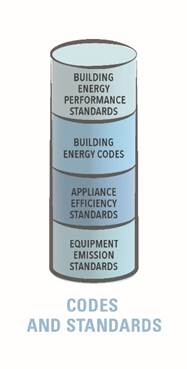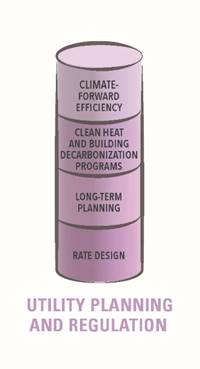

By Yiran He | Thu, July 18, 24
NEEP is delighted to debut our new policy framework for building decarbonization, titled Decarbonizing Buildings: How States Can Set the Table for Success, and developed in partnership with Northeast States for Coordinated Air Use Management (NESCAUM) and Regulatory Assistance Project (RAP). Building decarbonization is not easily solved by any single policy – this framework presents a comprehensive suite of policies that, together, can help states achieve their climate goals. We hope that readers will use this report as a lens to examine current policy structures, and as a roadmap to fill gaps in existing state policies.
This framework presents four key policy areas that can be thought of as legs of a table. These four categories together can help states achieve the goal of equitable building decarbonization. The four legs are essential because each accomplishes certain goals in achieving building decarbonization but has limitations in pace, scale, or reach.
The new framework describes a holistic approach towards equitable decarbonization at scale and at speed. These legs can guide state decisionmakers as they consider specific policy options and develop their own comprehensive strategy for building decarbonization by promoting cohesive, coordinated polices, balancing incentive-based and standard-based policies, and working towards a seamless marketplace experience for contractors and customers.
The Building Decarbonization Legs
Equity and workforce investments address housing and workforce inequities by empowering historically marginalized communities and ensuring that the energy transition is just and inclusive.
Focus on equity entails engaging stakeholders, establishing metrics and goals that outline success and hold actors accountable, designing home upgrade hubs to provide financing and technical assistance (especially for more complex projects such as in the multifamily sector), and working on inclusive workforce development that enables all communities to be a part of the clean energy transition.
Carbon reduction obligations set performance requirements for obligated parties, such as energy providers, to reduce carbon emissions or install clean heating systems.
A cap-and-invest program or a clean heat standard (CHS) scales down the total level of carbon emissions over time, without prescribing how carbon reductions are achieved. These programs can ensure that energy providers help pay for decarbonization investments, encourage changes in current business models, and create long-term incentives that unlock resources for the clean energy transition.
Codes and standards establish a clear timetable for improving the energy performance of buildings and equipment, spurring changes in technologies and building practices.
Mandatory policies such as building energy performance standards, building energy codes, appliance efficiency standards, and equipment emission standards require building owners, builders, or manufacturers to meet a certain level of building or technology performance. They set firm timelines for changing the market, providing certainty to manufacturers and grid operators in planning future investments.
Utility planning and regulation sets mandates and frameworks to ensure that utility investment, rates, and programs align with building decarbonization goals.
New program design should focus on climate-forward efficiency where programs focus on carbon reductions as well as energy and cost savings, and include clean heat and building decarbonization programs that offer incentives, financing, and technical assistance. Design should go with long-term planning, including transition planning for gas utilities, to align utility business models with state climate goals. Program rate design can directly encourage electrification while also advancing equity and climate goals.
How States are Setting the Table
Some jurisdictions have a few of these policies already in place. The report examines several real-world examples from the region and beyond that illustrate how different types of state policies can work together to tackle the complex challenge of building decarbonization.
California: equity and workforce investments + cap-and-invest + utility planning and regulation
California’s policy landscape includes a cap-and-trade program that provides some equity investments as well as utility regulations and plans. These types of broad-based carbon reduction standards can create a sustainable funding stream through the sale of allowances or by levying a charge on emitters. However, these policies are not sufficient to drive the change needed in specific market segments like the buildings sector or to drive equitable investment. Programs like TECH Clean California, funded by revenue from the state’s cap-and-invest program, fill a critical gap by directly incentivizing consumers and contractors to install equipment like heat pumps. Working together, these programs have increased adoption of heat pumps across California.
Maryland: building energy performance standards + clean heat standard + equipment emission standards + utility planning and regulation
Maryland has several important policies in place or being developed through its new comprehensive climate pollution reduction plan; as the policies are in early days, none of them have yet to be enforced. Both CHS and Building Energy Performance Standards (BEPS) in Maryland can prompt early replacements of equipment and other building upgrades to meet the standards. The plan’s proposed zero-emission heating equipment standard fills a policy gap by addressing emissions from equipment installed in smaller buildings that are not subject to the state’s BEPS and by preventing new installations of long-lived equipment that would still be operating after 2045. In turn, Maryland’s CHS will require obligated parties to deliver clean heat measures that reduce GHG emissions from heating buildings and can prevent overreliance on electric ratepayers for funding the clean energy transition. The state’s utilities are also required by regulation to establish GHG emissions reductions targets in metric tons.
Massachusetts: equity and workforce investments + clean heat standard + utility planning and regulation
Massachusetts runs several programs that work together to promote equity, electrification, and energy efficiency. Crucial enabling steps include changes to the utility regulatory framework, like requiring utilities to consider non-gas alternatives and to file Climate Compliance Plans every five years and establishing annual GHG emissions reductions goals by statute and the Secretary of Energy and Environmental Affairs. These changes alone, though, are not likely to prompt the level of investment needed to decarbonize the buildings sector at the pace required to achieve state climate goals. CHS will generate additional funding and promote the installation of clean heat appliances but must be well-coordinated with existing Mass Save programs and incentives. CHS fills a critical gap in regulation by imposing requirements on suppliers of unregulated, delivered fuels like oil and propane, which provide energy for home heating for nearly 30 percent of households in Massachusetts. The Commonwealth also has several equity initiatives, including an energy burden inquiry, workforce programs run through MassCEC, and new Community Climate Bank.
Washington D.C.: equity and workforce investments + building energy performance standards
In D.C., building energy performance standards are designed to help achieve equity goals. D.C. policymakers recognized that owners of affordable housing would need extra support to reach BEPS compliance and established the Retrofit Accelerator to fill this gap, leveraging a mix of federal and local funding sources. While penalties for non-compliance with BEPS offers one source of funding for programs that assist LMI building owners, the amount of funding generated through penalties is expected to be modest. Additional sources of funding beyond non-compliance penalties are needed to support incentive and technical assistance programs.
Washington state (transportation sector, using policies with analogues in the buildings sector): cap-and-invest + clean fuel standard + zero-emission vehicle standard
Washington state provides an example of these policies designed to work together to accomplish transportation decarbonization goals. While carbon reduction obligations such as the state’s cap-and-invest program provide overarching policy direction and compliance flexibility, they may need to be paired with sector-based policies. These policies should be aligned and coordinated. For example, the clean fuel standard and the zero-emission vehicle standard are both sector-specific policies under Washington’s broader cap-and-invest program, but they impose requirements on different obligated parties: fuel suppliers and vehicle manufacturers, respectively.
What’s Next?
To effectively set the table for equitable building decarbonization, states should advance policies across all four legs identified in this brief: equity and workforce investments, carbon reduction obligations, codes and standards, and utility planning and regulation.
Building decarbonization strategies will be most effective when all their elements work well together. Much work remains for states in our region and beyond to fully set the table for building decarbonization. We expect states will see the strongest results when they promote cohesive, coordinated policies across agencies; balance incentive-based and standard-based policies; work towards a seamless marketplace experience; and track results and GHG impacts across multiple programs.
